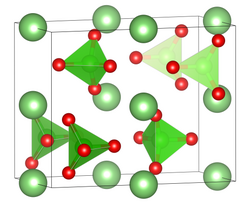Lithium perchlorate
 | |
 | |
| Names | |
|---|---|
| IUPAC name
Lithium perchlorate
| |
| Other names
Perchloric acid, lithium salt; Lithium Cloricum
| |
| Identifiers | |
3D model (
JSmol ) |
|
| ChemSpider | |
ECHA InfoCard
|
100.029.307 |
PubChem CID
|
|
| UNII | |
CompTox Dashboard (EPA)
|
|
| |
SMILES
| |
| Properties | |
| LiClO 4 | |
| Molar mass |
|
| Appearance | White crystals |
| Odor | Odorless |
| Density | 2.42 g/cm3 |
| Melting point | 236 °C (457 °F; 509 K) |
| Boiling point | 430 °C (806 °F; 703 K) decomposes from 400 °C |
| |
| Solubility | Soluble in alcohols, ethyl acetate[1]
|
| Solubility in acetone | 137 g/100 g[1] |
alcohols
|
|
| Solubility in ethyl acetate | 95.2 g/100 g[2] |
ethyl ether
|
113.7 g/100 g[2] |
| Structure | |
| Pnma, No. 62 | |
a = 865.7(1) pm, b = 691.29(9) pm, c = 483.23(6) pm[3]
| |
Formula units (Z)
|
4 formula per cell |
tetrahedral at Cl
| |
| Thermochemistry | |
Heat capacity (C)
|
105 J/mol·K[1] |
Std molar
entropy (S⦵298) |
125.5 J/mol·K[1] |
Std enthalpy of (ΔfH⦵298)formation |
−380.99 kJ/mol |
Gibbs free energy (ΔfG⦵)
|
−254 kJ/mol[1] |
| Hazards | |
| Occupational safety and health (OHS/OSH): | |
Main hazards
|
Oxidizer, irritant |
| GHS labelling: | |
  [4] [4]
| |
| Danger | |
| H272, H315, H319, H335[4] | |
| P220, P261, P305+P351+P338[4] | |
| NFPA 704 (fire diamond) | |
| Safety data sheet (SDS) | MSDS |
| Related compounds | |
Other anions
|
Lithium chloride Lithium hypochlorite Lithium chlorate |
Other cations
|
Sodium perchlorate Potassium perchlorate Rubidium perchlorate |
Except where otherwise noted, data are given for materials in their standard state (at 25 °C [77 °F], 100 kPa).
| |
Lithium perchlorate is the inorganic compound with the formula LiClO4. This white or colourless crystalline salt is noteworthy for its high solubility in many solvents. It exists both in anhydrous form and as a trihydrate.
Applications
Inorganic chemistry
Lithium perchlorate is used as a source of oxygen in some chemical oxygen generators. It decomposes at about 400 °C, yielding lithium chloride and oxygen:[5]
- LiClO4 → LiCl + 2 O2
Over 60% of the mass of the lithium perchlorate is released as oxygen.[2] It has both the highest oxygen to weight and oxygen to volume ratio of all practical perchlorate salts, and higher oxygen to volume ratio than liquid oxygen.[6]
Lithium perchlorate is used as an
Organic chemistry
LiClO4 is highly soluble in organic solvents, even diethyl ether. Such solutions are employed in
Lithium perchlorate is also used as a
Solid lithium perchlorate is found to be a mild and efficient Lewis acid for promoting cyanosilylation of carbonyl compounds under neutral conditions.[10]
Batteries
Lithium perchlorate is also used as an
Biochemistry
Concentrated solutions of lithium perchlorate (4.5 mol/L) are used as a chaotropic agent to denature proteins.
Production
Lithium perchlorate can be manufactured by reaction of sodium perchlorate with lithium chloride. It can be also prepared by electrolysis of lithium chlorate at 200 mA/cm2 at temperatures above 20 °C.[12]
Safety
Perchlorates often give explosive mixtures with organic compounds, finely divided metals, sulfur, and other reducing agents.[12][2]
References
- ^ a b c d e f g "Lithium perchlorate". chemister.ru.
- ^ US Army Materiel Command. October 1963. pp. 181–182.
- .
- ^ a b c Sigma-Aldrich Co., Lithium perchlorate. Retrieved on 2014-05-09.
- .
- OL 37082807M.
- LCCN 61-61759.
- .
- ^ [1] Lithium Perchlorate Product Detail Page
- .
- ^ PMID 15669157. Retrieved 24 February 2014.
- ^
Fuerther reading
- Schmidt, Eckart W. (2022). "Alkali Metal Chlorates and Perchlorates". Perchlorate Oxidizers. Encyclopedia of Oxidizers. De Gruyter. pp. 3752–3761. ISBN 978-3-11-075029-4.

